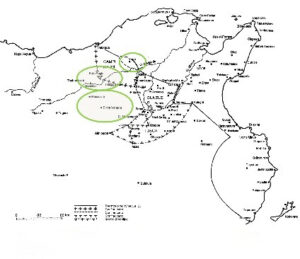Tunisia is rich in deposits of iron and to a lesser extent lead. The exploitation of these resources is documented during the Carthaginian era particularly in the western area of the country, in the region of ancient Vaga (today Beja) in the Carthaginian district Campi Magni.
Vaga, the possible capital of the district, must have fulfilled the role of the primary collector of agricultural and mineral resources from the Nefra and Bulla Regia basin, rich in iron, lead and copper.
In this region, Thibigga Bure, a possible centre for the extraction of lead that was probably also exploited in Punic times, the remains of a sacred area dedicated to Saturn with Neo-Punic stelae and a necropolis from the middle of the 2nd century B.C.-I century A.D. with Punic material have been brought to light. The site appears to be part of the complex system of fortified centres that stretched from Carthage to the pagus Thuscae.
The ‘belt’ closest to Carthage consisted of sites such as Nepheris, Uthina, Tunes, followed about 60 km from the metropolis by a second series of sites in Zaghouan, Srmingi, Jebel Moraba.
Beyond this region extended an area without fortifications with an agricultural vocation, closed to the south by other strongholds including Uzali Sar, Tuccaba. Also fortified seems to have been the mining region of Thugga towards the west with sites such as Thignica, Thighidda Bure, and towards the ridge with Limisa as if following a possible frontier line in Numidian territory, which would alternate, here too, with the agricultural areas of the Saradi region and the upper Siliana valley. In the territories closest to Carthage, therefore, an extremely articulated anthropic situation seems to emerge, with a mixed settlement module: agricultural, mining, and fortified settlements alternating in a successive series of belts placed to protect the Punic capital, even if there are not enough indications to assess how this complex system fitted into the Carthaginian administrative organisation of the territory by districts.
In the state territory of Carthage (roughly present-day Tunisia) there is little and indirect evidence of the specific social role played by metalworkers. However, the guild of gold smelters is attested on the ‘urban’ inscription of Carthage (?) from the 3rd century BC. The generic trade of nsk (smelter) appears on the tophet stelae of Carthage. Again, on the city’s stelae the term is attested with the specification of gold smelters, nsk ḥrṣ/ ‘nsk ḥrṣ, bronze smelters, msk ḥnhšt, and iron smelters, nsk hbrzl, the latter also recorded on a funerary inscription. Also recorded on Carthaginian stelae is the expression defining molten metal, nsk hnskt. Also referable, like the inscriptions, to a time span between the 3rd and 2nd centuries B.C., are the iconographic attestations referring to tools such as pincers, hammers, bellows. The trade also appears on a funerary inscription from a tomb in Kerkouane, on a painted amphora from Sousse, and on epigraphs from Tèboursouk, Cirta and Thugga. It can therefore be concluded that the epigraphic documentation does not show any special characteristics for metalworkers compared to other categories of artisans other than their possible belonging to a guild, which suggests their social status as free persons. However, it should be emphasised that the known epigraphic documentation refers to activities related to the last phase of the transformation of metal into finished objects, which took place in advanced urban contexts. No indications seem to be related to the earlier phases of mineral processing.

